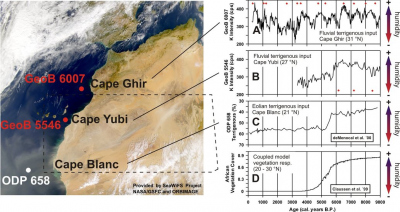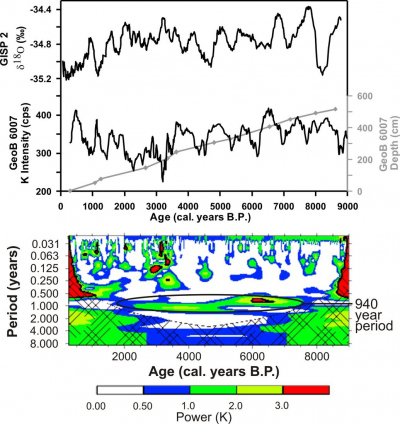Seitenpfad:
- Startseite
- Holger Kuhlmann
- Holozäne Zyklen
Holozäne Zyklen

Figure 1: Climate records off NW Africa reflecting a periodic oscillation in the N Atlantic climate system (A) and the monsoonal influence in the early-Holocene (B, C, D). A, B Potassium (K) intensity in counts per second (cps) as indicator for fluvial terrigenous input at sites GeoB 6007 and GeoB 5546, red dots indicate the 14C AMS dates. C Eolian terrigenous input (inverted scale) at ODP site 658 from [deMenocal, et al., 2000]. D Fractional vegetation cover (grass fraction) representing the entire Saharan region from [Claussen, et al., 1999].
References
Claussen, M., C. Kubatzki, et al. (1999). "Simulation of an abrupt change in Saharan vegetation in the mid-Holocene." Geophysical Research Letters 26(14): 2037-2040.
deMenocal, P., J. Ortiz, et al. (2000). "Abrupt onset and termination of the African Humid Period: rapid climate responses to gradual insolation forcing." Quaternary Science Reviews 19(1-5): 347-361.
References
Claussen, M., C. Kubatzki, et al. (1999). "Simulation of an abrupt change in Saharan vegetation in the mid-Holocene." Geophysical Research Letters 26(14): 2037-2040.
deMenocal, P., J. Ortiz, et al. (2000). "Abrupt onset and termination of the African Humid Period: rapid climate responses to gradual insolation forcing." Quaternary Science Reviews 19(1-5): 347-361.

Figure 2: Comparison of 300 year running averages applied on the oxygen isotope record from the GISP 2 ice core (A) and the Potassium (K) intensity of site GeoB 6007 (B). Age-Depth relationship is indicated by the grey line, dots indicate the 14C AMS dates. C Wavelet analyses of the unsmoothed K record of site GeoB 6007 was performed by using the online facility of the Program in Atmospheric and Oceanographic Science at the University of Colorado at Boulder (http://paos.colorado.edu/research/wavelets/) [Torrence and Compo, 1998]. We used Morlet wavelet (frequency parameter equal 6), a starting scale of 2 (expressed as a fractional power of two), scale width 0.25 and a 5% significance level.
References
Torrence, C. and G. P. Compo (1998). "A practical guide to wavelet analysis." Bulletin of the American Meteorological Society 79(1): 61-78.
References
Torrence, C. and G. P. Compo (1998). "A practical guide to wavelet analysis." Bulletin of the American Meteorological Society 79(1): 61-78.


